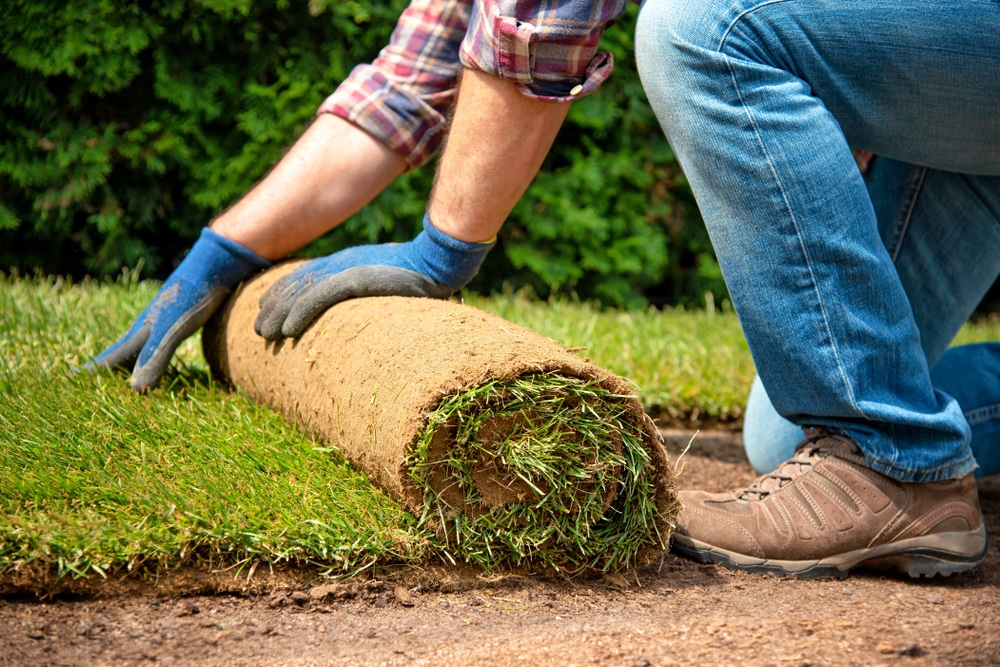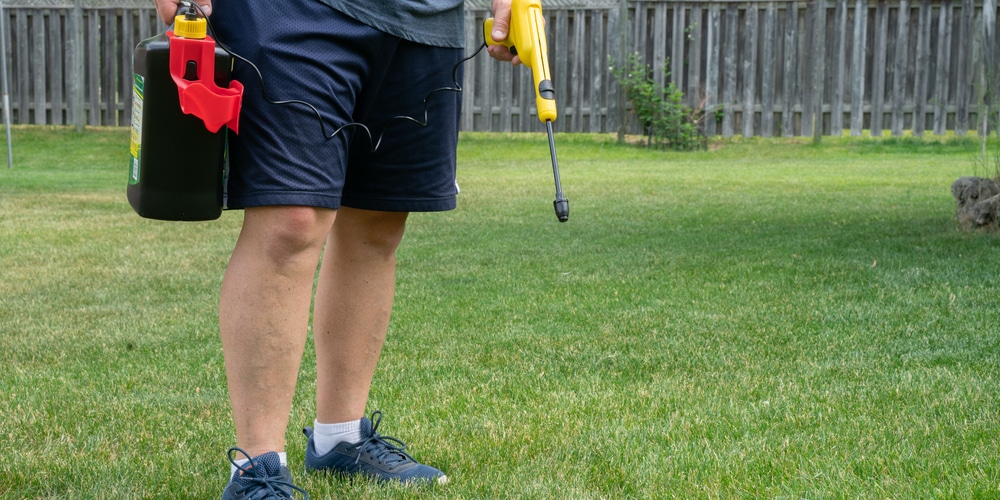Weed Control Before Seeding: The Basics
Proper weed control is essential when you’re preparing to plant a new lawn.
Weeds not only compete with grass for space, nutrients, and water, but they can also hinder the growth and development of your desired grass species.
Here is how to take charge of weed management before you introduce grass seed.
Pre-Planting Strategies:
- Identify Weeds:
- Determine the types of weeds present; understanding whether they are annual, biennial, or perennial weeds can dictate the treatment method.
- Mechanical Removal:
- Use tools like hoes or weed pullers for immediate weed removal. This is labor-intensive but ensures immediate clearance.
Chemical Control:
- Selecting Herbicides:
- Choose selective herbicides that target weeds but will not harm your future grass as described on Storables.
- Utilize pre-emergent herbicides to prevent weed seeds from germinating.
Soil Preparation:
- Test Soil:
- A soil test will reveal nutrient deficiencies and allow you to amend the soil for optimal grass growth.
- Tilling:
- Loosen the soil to improve grass seed contact and encourage root growth. Be mindful, as tilling can bring dormant weed seeds to the surface.
Environmentally Friendly Options:
- Solarization:
- This method uses clear plastic to trap the sun’s heat, effectively killing weeds before seeding.
Soil Preparation for Planting
Before sowing grass seed, it’s critical to properly prepare your garden’s canvas—the soil. Ensuring your soil is ready not only aids in weed elimination but also supports healthy grass growth.
Identifying Soil Type
- Sandy Soil: This type drains quickly but can struggle to hold nutrients and moisture.
- Clay Soil: Nutrient-rich, yet poorly draining and prone to compaction.
- Loamy Soil: The gold standard for gardening, with a balance of drainage and nutrient retention.
- Silt Soil: Fine-textured, retains water well but can become compacted easily.
To determine your soil type, feel its texture. Sandy soil feels gritty, clay is sticky, silt is smooth, and loam is a balance of the three.
Consider performing a soil test for a more detailed understanding of your soil’s composition and pH level.
Improving Soil Quality
- Address Soil pH:
- If your soil is too acidic or alkaline, it’s important to adjust the pH to a level that is conducive to growing grass. Lime can be added to acidic soil, whereas sulfur may be needed for alkaline soil.
- Enhance Soil Fertility:
- Incorporate organic matter like compost or well-rotted manure to boost soil fertility. This is particularly beneficial for sandy or clay soils.
- Boost Drainage:
- For clay or silt soils, add coarse sand or organic matter to enhance permeability and prevent waterlogging.
- Aerate Compacted Soil:
- Use a garden fork or core aerator to puncture the soil and improve air and water movement.
Selection and Timing of Herbicides
Choosing the right herbicides and applying them at the correct time are crucial steps to ensure your future lawn is weed-free. Proper selection prevents weed growth, while timing maximizes the effectiveness of the treatment without harming the grass.
Pre-Emergent Herbicides
- What You Need: Pre-emergent herbicides are designed to stop weed seeds from germinating. Your goal is to create an invisible shield that prevents weeds from establishing in the first place.
- When to Apply:
- These herbicides are most effective when applied before the weed seeds germinate, typically in early spring when soil temperatures consistently reach about 55°F.
- Make sure to apply pre-emergent herbicides before you see any weeds, as once they’ve sprouted, pre-emergents won’t be effective.
Check the timing chart for lawn weed control to align your application with the type of weeds in your region.
Post-Emergent Herbicides
- What You Need: Post-emergent herbicides come into play after the weeds have sprouted. They are absorbed by the visible weeds and work to kill them off.
- When to Apply:
- Use post-emergent herbicides when you see weeds growing in your lawn. They can target specific types of weeds without harming your grass when used properly.
- Application times vary depending on the type of weed and product instructions; however, generally, you’ll want to apply during active growth phases for best results.
Grass Seed Selection and Planting
When choosing the right grass seed, consider your local climate and soil conditions. Different grass varieties thrive under specific circumstances and choosing the correct type can make a significant difference in growth success.
For example, cool-season grasses like Kentucky bluegrass and fescue prosper in northern climates, while warm-season grasses, such as Bermuda and Zoysia, are better suited for southern regions.
Steps for Planting Grass Seed:
- Test Your Soil: Before selecting your grass seed, conduct a soil test to determine pH and nutrients.
- Pick the Right Seed: Select a grass seed that fits your regional climate and sunlight exposure.
- Prepare the Ground: Clear the area of weeds and debris. Loosen the top 2-3 inches of soil.
- Sow the Seed: Spread the seed evenly using a spreader. For larger areas, consider a broadcast spreader; for smaller spots, a handheld spreader may suffice.
- Rake Lightly: Integrate the seeds lightly into the soil for better soil contact.
- Water Regularly: Water your new lawn twice daily to keep the soil moist until the seeds germinate.
Suitable Conditions for Common Grass Types:
| Grass Type | Climate | Sunlight | Water Needs |
|---|---|---|---|
| Kentucky Bluegrass | Cool | Full sun/partial shade | Moderate |
| Fescue | Cool | Partial shade | Moderate |
| Bermuda | Warm | Full sun | High |
| Zoysia | Warm | Full sun/partial shade | Low |
Maintenance After Planting
After the seeds have been sown, your focus must shift to fostering a lush, weed-free lawn through vigilant maintenance.
Watering and Fertilizing
- Water: Begin by watering your new grass twice a day for the first few weeks to keep the soil consistently moist but not waterlogged. Gradually reduce the frequency as your grass becomes established.
- Fertilizer: At about four to six weeks, when your grass has germinated, it’s ready for the first round of fertilizer. Opt for a balanced fertilizer that suits the specific grass type you have grown.
Monitoring and Secondary Weeding
- Weed Watch: Keep an eye on emerging weeds and remove them promptly.
- The younger the weed, the easier it is to control.
- Post-Emergent Herbicide Application: If necessary, apply a post-emergent herbicide appropriate for your grass type and target weeds.
- This is generally done 4 to 6 weeks after the grass seedlings have appeared.
Frequently Asked Questions
Before you embark on the journey to a lush, weed-free lawn, it’s crucial to tackle common questions about removing weeds prior to planting grass seed.
Ensure your efforts result in the pristine lawn you’re aiming for by adhering to the best practices outlined below.
How do I effectively remove weeds prior to seeding my lawn?
- To effectively remove weeds before seeding, first manually pull out any large weeds.
- Consider applying a pre-emergent herbicide to prevent new weeds from emerging, followed by tilling the soil to uproot any remaining weeds.
Is it necessary to eliminate all existing weeds before overseeding an area?
- Yes, removing all weeds is advised to ensure the new grass isn’t outcompeted for essential resources.
- For overseeding, the distinction lies in the fact that existing turf provides a foundation but still requires a weed-free environment for optimal growth.
What type of herbicide should be used to clear weeds without harming new grass growth?
- Selective herbicides target specific weed species while leaving grass unharmed.
- Read labels carefully or seek products designed for use in lawn preparations.
Can I plant new grass seed immediately after applying weed killer, or is there a recommended waiting period?
- Typically, a waiting period after applying herbicide is necessary to ensure it doesn’t affect the new grass.
- The recommended waiting period may range from a few days to weeks, depending on the product used.
Are there methods to suppress weeds while simultaneously encouraging grass seed germination?
- Mulching can suppress weeds and aid in moisture retention for grass seeds.
- Additionally, use a starter fertilizer that promotes seed germination while inhibiting weed growth.
Is it possible to lay grass seed over an area with weeds, or should the weeds be removed first?
- Weeds should be removed prior to laying grass seed to prevent competition for sunlight, water, and nutrients.
- Ensuring a weed-free area before seeding maximizes the chances of successful grass establishment.
Last update on 2025-03-31 / Affiliate links / Images from Amazon Product Advertising API




